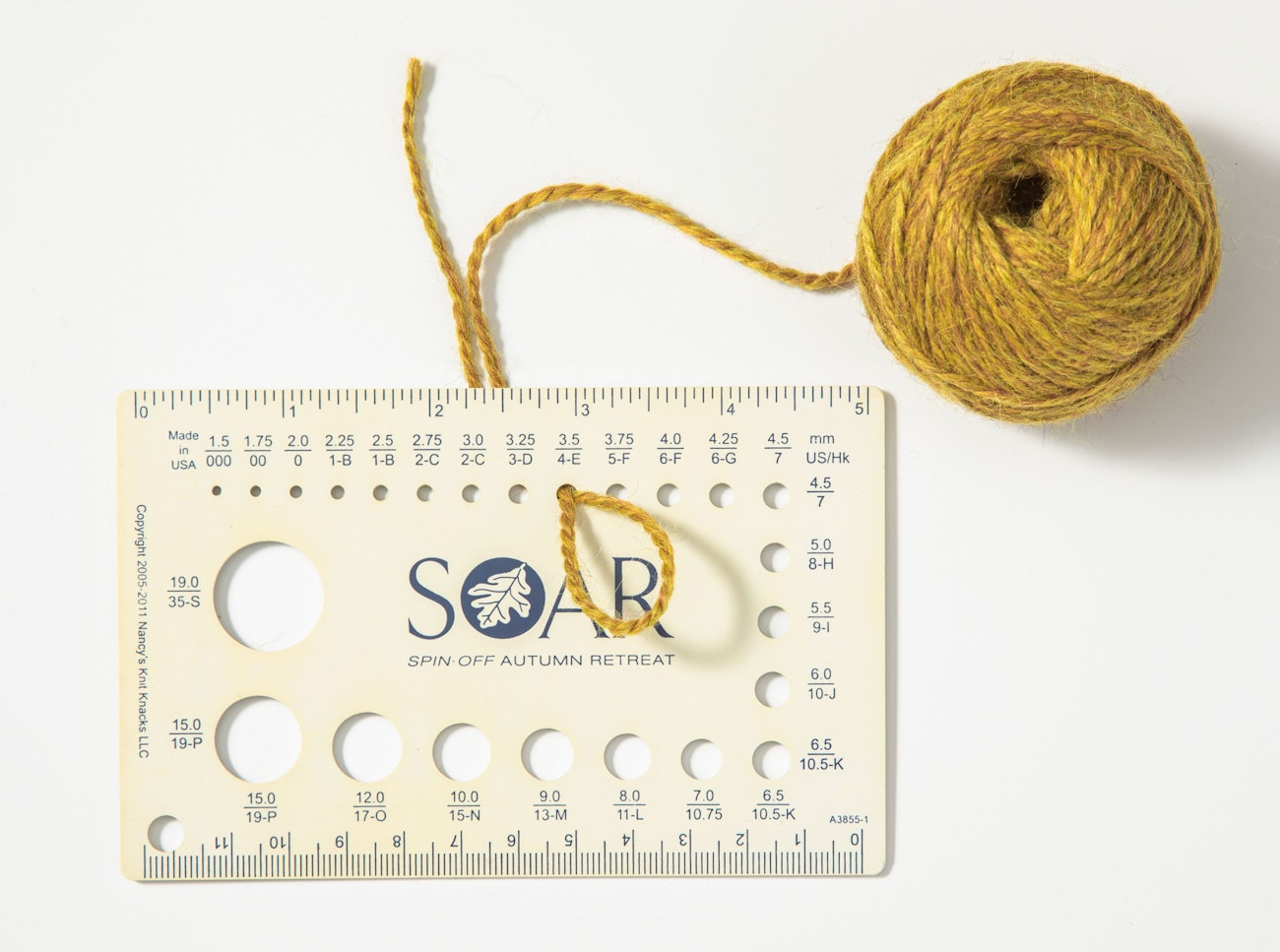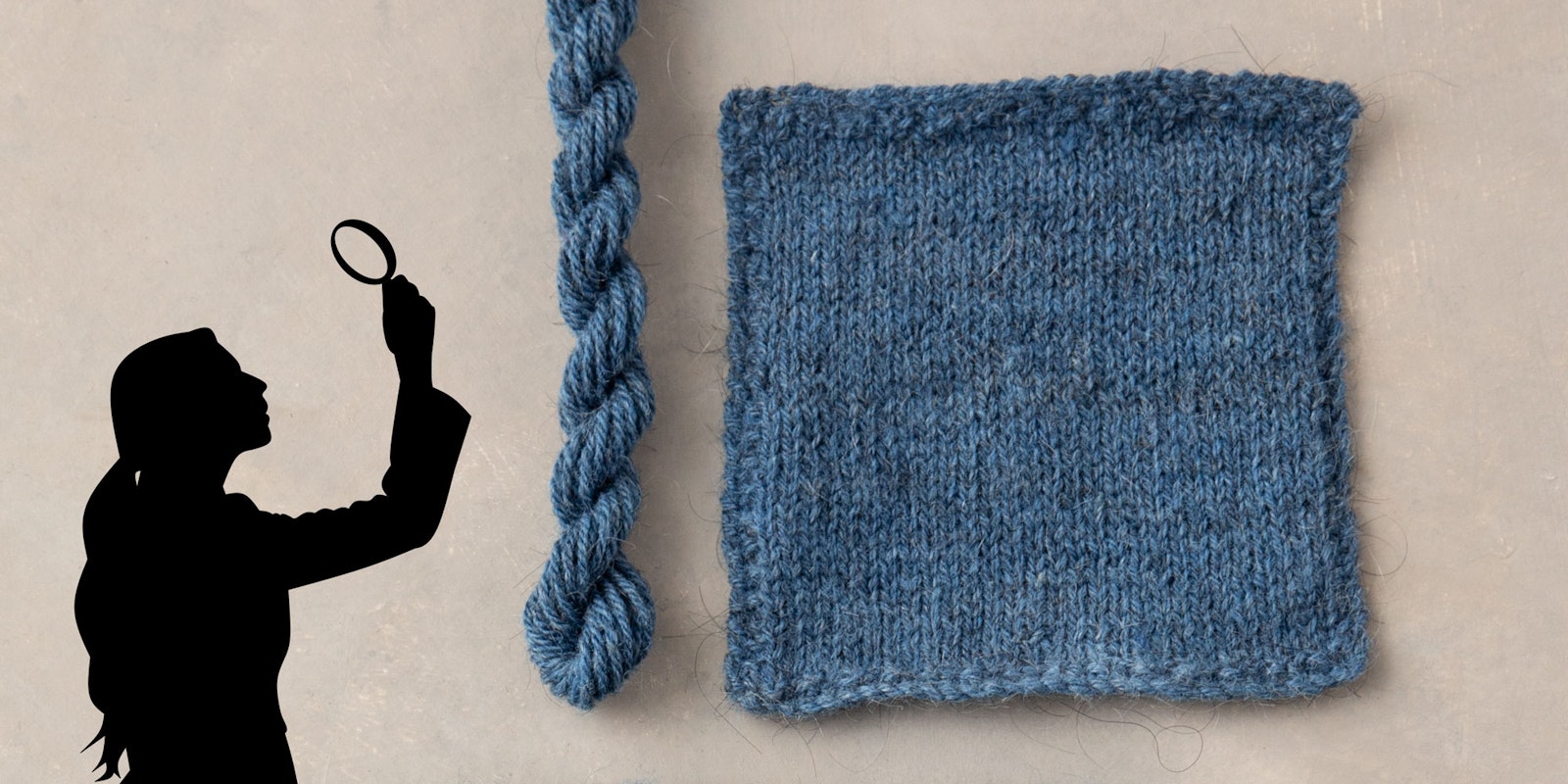Subscriber Exclusive
How to Knit with Mystery Yarn
Read on for some tips about working with that mystery yarn you just couldn’t leave behind.
Read on for some tips about working with that mystery yarn you just couldn’t leave behind. <a href="https://farmfiberknits.com/got-gauge/">Continue reading.</a>
https://farmfiberknits.com/cdn-cgi/image/format=auto/https://www.datocms-assets.com/101500/1692054672-210728_sow22-122-header.jpg?auto=format&w=900
So you’ve picked up a skein or two of irresistible yarn of unknown provenance—maybe the color caught your eye, or you just couldn’t get enough of touching it. But if there’s no label to indicate weight, gauge, yardage, how do you know what to do with it?
Most knitting patterns are written for a particular yarn weight, such as fingering or worsted. You can use a WPI (wraps per inch) tool to help estimate the weight of your yarn, or you can fold a piece of yarn in half and insert it through the holes in a knitting needle gauge. When you find the smallest hole through which the yarn passes easily, try using the corresponding needle size to knit the yarn.

For a quick way to guess at the right needle size for a mystery yarn, make a loop and draw it through a few holes in a knitting needle gauge. When you find the smallest hole that the yarn can easily pass through, start swatching with that size needle. Photo by Matt Graves
Now, how much yarn do you have what about yardage? You can use a tool like a McMorran Balance to estimate the length, but this works best for yarns that are consistent in diameter and density throughout the whole skein. If you suspect your yarn is handspun, or if it just looks thick-and-thin, it’s better to get a rough direct measure of it. Lay the skein on a flat surface and measure the length. Count the strands of yarn on one side, multiply by 2, and multiply that by the length. If you measured in inches, divide by 36 to get the length in yards. It’s not exact, but it gives you a ballpark figure. aAnd because this method slightly underestimates the amount of yarn, you’re less likely to run out mid-project.
SUBSCRIBER EXCLUSIVE
So you’ve picked up a skein or two of irresistible yarn of unknown provenance—maybe the color caught your eye, or you just couldn’t get enough of touching it. But if there’s no label to indicate weight, gauge, yardage, how do you know what to do with it?
Most knitting patterns are written for a particular yarn weight, such as fingering or worsted. You can use a WPI (wraps per inch) tool to help estimate the weight of your yarn, or you can fold a piece of yarn in half and insert it through the holes in a knitting needle gauge. When you find the smallest hole through which the yarn passes easily, try using the corresponding needle size to knit the yarn.

For a quick way to guess at the right needle size for a mystery yarn, make a loop and draw it through a few holes in a knitting needle gauge. When you find the smallest hole that the yarn can easily pass through, start swatching with that size needle. Photo by Matt Graves
Now, how much yarn do you have what about yardage? You can use a tool like a McMorran Balance to estimate the length, but this works best for yarns that are consistent in diameter and density throughout the whole skein. If you suspect your yarn is handspun, or if it just looks thick-and-thin, it’s better to get a rough direct measure of it. Lay the skein on a flat surface and measure the length. Count the strands of yarn on one side, multiply by 2, and multiply that by the length. If you measured in inches, divide by 36 to get the length in yards. It’s not exact, but it gives you a ballpark figure. aAnd because this method slightly underestimates the amount of yarn, you’re less likely to run out mid-project. [PAYWALL]
Advice from Ann Budd
If you are open to starting your mystery yarn project with a gauge swatch, there’s hardly a better resource than Ann Budd’s Knitter’s Handy Book series. Ann’s well designed patterns are enhanced by copious tables and schematics for just about every gauge and size. You can use a huge variety of yarns to make all kinds of garments and accessories. Ann is a dedicated swatcher. “Knitters who jump in without knitting a gauge swatch should be prepared for failure,” she says.
If your special yarn is handspun or seems a little uneven, though, a gauge swatch may not be as reliable. Ann gives some great advice for working with yarns like this. One technique is to weigh or measure out and cut your yarn into approximately 50-gram balls, then randomly switch which ball you’re using as you knit. This will, of course, result in many more ends to weave in, but it will help make inconsistencies in your yarn less noticeable in the finished piece.
What Should I Knit?
Ann also suggests choosing patterns that are worked in the round rather than seamed. Why? Imagine knitting two front panels and discovering when it’s time to seam them that because of slight inconsistencies in your handspun, they don’t quite match up in length. Knitting in the round will save you the frustration of trying to force the two pieces to line up. Working in the round also spreads out excessively thick or thin sections over a large section of the garment rather than concentrating them in one small, potentially obvious area.
Unlike plain stockinette stitch, moss stitch and other textured stitches draw attention away from the yarn itself. “The eye sees the texture pattern more than the inconsistencies,” says Ann.
If you notice that your mystery yarn is finer at one end versus the other—this can happen with handspun if the spinner isn’t paying super close attention—or if your skeins are not quite the same in grist, look for a pattern that starts narrow and get wider, like a triangular shawl. Choose a pattern that starts at the narrow point of the triangle and cast on with the finer end of the yarn. Because the general shape of the pattern goes from narrow to wide, the change in the diameter of the yarn won’t be so obvious. You can also switch to a bigger needle size as the yarn changes in width to get a more consistent feel to the fabric. This type of pattern will also let you use up every last yard—when you get near the end of the skein, simply bind off.
 Kate's Simple Shawl begins with just a few stitches and grows wider as you go, making it the perfect gaugeless knit. Photo by Kate Larson
Kate's Simple Shawl begins with just a few stitches and grows wider as you go, making it the perfect gaugeless knit. Photo by Kate Larson
If you have a large quantity of fairly consistent yarn and the burning desire to get started, consider a small gaugeless project such as a quilt square, small toy, or beret first. If you like the finished item, then you can use that as a gauge swatch of sorts before jumping into a bigger and more committed project. Try to match techniques and needle sizes between the two projects, though. For example, if your bigger project is in stockinette, make sure the small one is in stockinette as well. The same applies to working in the round versus knitting back and forth.
It may take a little more work, but turning your mystery yarn from stash ornament to usable item is well worth the effort!
Links
Tool Basics: Wraps Per Inch Tool
How to Use a McMorran Balance
A version of this article previously appeared in Spin & Knit 2017.
Leslie Ordal is a genetic counselor and academic based in Toronto, Ontario. She can often be seen knitting with her own handspun yarn during department meetings and has recently begun to spin her own embroidery thread, preferably dyed with locally foraged plants. Some of her fibre arts adventures are documented at leslieordal.com.



 Kate's Simple Shawl begins with just a few stitches and grows wider as you go, making it the perfect gaugeless knit. Photo by Kate Larson
Kate's Simple Shawl begins with just a few stitches and grows wider as you go, making it the perfect gaugeless knit. Photo by Kate Larson